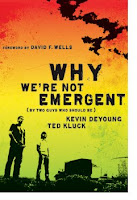Is It Time For The Post-Missional Church?
 Useful observations about the world are often made when things shift and change. We can compare the new to what came before. For instance, we talk about “post-war Britain”; it was different, but related, to the Britain of earlier generations. We can make similar observations about the shifts and changes in how we do church.
Useful observations about the world are often made when things shift and change. We can compare the new to what came before. For instance, we talk about “post-war Britain”; it was different, but related, to the Britain of earlier generations. We can make similar observations about the shifts and changes in how we do church.
In recent decades, the greatest shift has been into postmodernity. This worldview took the building blocks that made up “modern man” and reconstructed them. In the modern world the church’s posture was intellectual defence (apologetics), explanation and persuasion. Robust debates and gospel explanation from the likes of Billy Graham were the tools of the time. The question we sought to answer was “Is Christian faith reasonable?”
The postmodern world launched out from modern rationalism and a positive view of human progress and took us to the subjective human experience of truth, and a re-emphasis on belonging and community. The church followed; we began to emphasise the experience of the gospel. Early (ca. 1970s) movements formed closer knit relationships, through things like cell church, and enthusiastic charismatic experiences. The missional church is grounded in these modes. They became systematised and commercialised through the 80’s and 90’s, giving rise to the “seeker sensitive” and homogenous-unit (special-focus group) structures that are the defaults of most evangelical churches today. This is the world of the Alpha Course, and the default Sunday pathway for growing up through creche, pre-school, children, and youth programs towards our eventual ecclesial self-fulfillment.
We have also seen a late-stage postmodern pushback at how this became commercialised and conservative. Charismatics have morphed into contemplatives. Greenbelt, which once played the now-oh-so-mainstream Michael W. Smith and Amy Grant, now sits at the feet of secular sages such as Russell Brand. The “emerging” and the “emergent” parted ways. Steve Chalke, Tony Campolo, John Smith (for you Aussies), all jumped to the left. It was a shift in expression, the rise of postevangelicalism, but it was still postmodern underneath.
Throughout the postmodern age we have been playing in a pluralist world. The question we were seeking to answer was “Does the Christian faith belong, and can we belong to it?”
The world is now shifting into post-postmodernity. The pluralist project is dead; we live in a world of competing metanarratives that are overt in their attempts to totalise and win. So-called “wokeism” coerces through cancel culture and an attempt to establish its own pseudo-religion of signalled virtue. So-called Trumpism, at the other end of the spectrum, does the equal but opposite. Each is anathema to the other, and the demand is to pick a side. The question that is forced upon us is this: “Is Christianity actually ethical and moral at all?”; which is to say, are those Christians on the “right” side?
In the post-postmodern world, our postmodern missional response no longer cuts it. The techniques for weaving worldview and experiences together to spin the narrative, change hearts and minds, and win converts, are now ubiquitous in every sphere, and usually harmful. Our missional methodology buys into that game, whether we mean it to or not. Amidst the cynicism are the real stories of people who are victims and survivors of mission’s cold pragmatism. We used to target the “unchurched and de-churched” who needed to be “won back”; now we have the growing phenomenon of the “dones” – those who have left the church, not because they have lost their faith, but because their faith has lost its place and people. I know from our experience what it means to walk alongside a new young Christian, and realise that the path of discipleship they needed was away from the programmed precision of their local church.
It’s time for a post-missional church. Somehow we need to follow Jesus into and through the post-postmodern world, to somehow transcend the culture wars, and by some miracle reach a cynical generation. It seems impossible, it’s hard to imagine; but that’s always the case when things start to change and shift.
There is a real danger of slipping into either triumphalism or nihilism. I hear and see both at work. The existential question of the post-postmodern world ties virtue to a reason for being; “I am good, therefore I am,” is the mantra of the day. With nihilism, the church is rendered as bad and therefore meaningless and unworthy of existence; it’s when we agree with the world that the church is toxic, in the same category as toxic masculinity, heteronormativity, and other privilege, and so our moral duty is to fade away and rid the world of our corruption. The alternative takes us to triumphalism; we validate our existence by asserting our infallible, unquestionable, virtue, and we thump our Bibles against the fake news. Both options are untenable; they don’t really look like Jesus.
We must discern a way forward. That is a big question, and I don’t have the answer. But we can look to the changes and the shifts, and pick it up as prayerful project.
This is something I want to do, and I’d like to do it in community. Would you join me in observing the shifts and changes around us, and by imagining a post-missional church? Here is my attempt at an initial brainstorm of comparison. Note that these are observations of what has been, and what might be, not assertions of how it should be. I’d very much welcome your input and thoughts. Get in touch with me in the comments or through my other points of connection.
Characteristics of church (initial brainstorm):
| Modern / “Christendom” Church | Postmodern / Post-Christendom / “Missional” Church | Post-Missional Church? | |
| Placement in Society | Established institution presumed to exist. | Institution in the marketplace, competing for market share. | Heavily localised, perhaps even fragmented; akin to “pop-up” economy. Relationally unified. |
| Structure | Hierarchical, pastor-centric. | Semi-hierarchical; devolution to smaller groups as an asset for the larger whole. | Personality and cause-based. Structures reflecting networks of trust akin to social media. |
| Resources | Institutional responsibility, legacy finances, tithing. | Congregational giving, side-business investments, and “raise your support” employment. | Bivocationalism. Also patronage (i.e. directed assistance to person or cause, rather than tithes into a common pool). |
| Goal | Keep people in church, help them know Jesus. | Help people know Jesus, get them into church. | Be with people who want to know Jesus, make that church. |
| Source of spiritual authority. | Qualification and Authorisation; expressed in didactic teaching, liturgical worship, elevation of an order of leaders. We look to who is in charge. We are exhorted to “learn the truth.” | Experience and Pragmatism; expressed in dialogical teaching, stimulating events + small groups, elevation of “effective” programs and people. We look to who or what works for us, and are exhorted to “walk in your gifting and destiny.” | Kenosis and Sacrifice: expressed as a recognition of costly faith, elevation of those (both contemporary and ancient) who have had a proving experience. We look to who has been through the fire, and are exhorted to “lose your life so that you might save it.” |
| Modes of discipleship. | Standardised, formal, and curriculum based. | Formalised action-reflection, mentoring, coaching. | Rhythm of life, monastic, familial. |
| Aspiration in worship.* | Service | Growth | Adoration |
| ? |
* = Subsequently added in edit.
Photo credit: SimonAr




